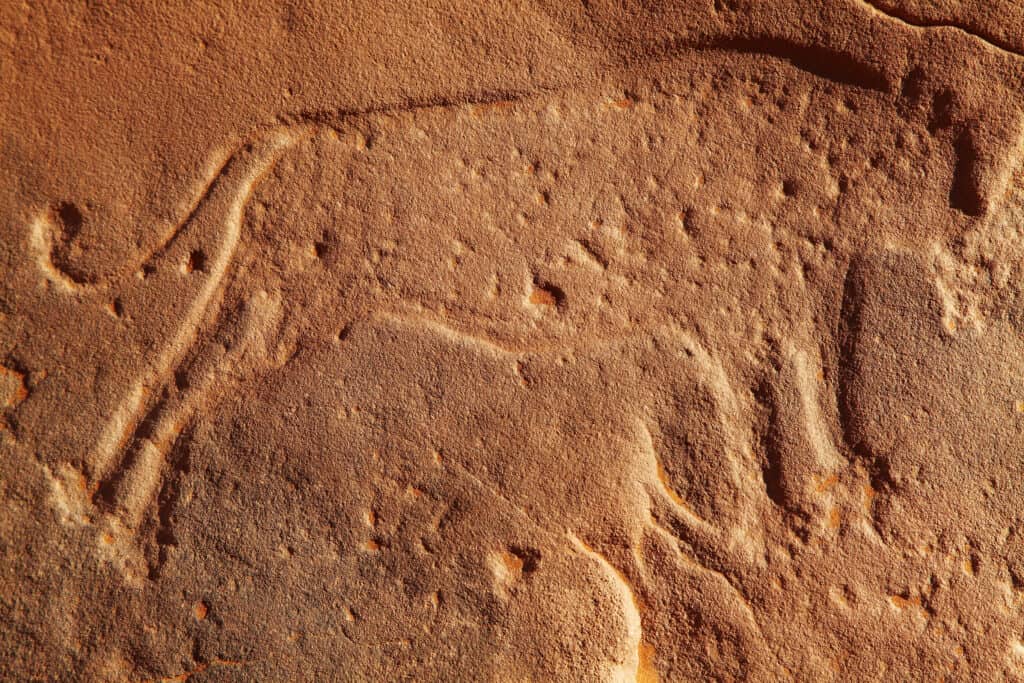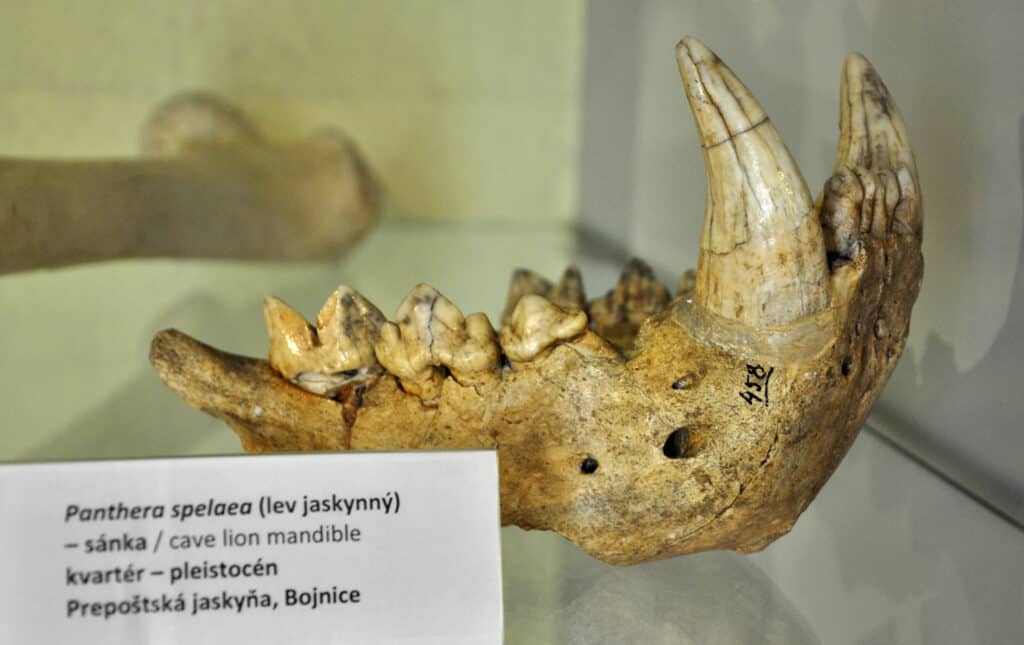These days, when we think of an animal with a distinct mane, predatory skulk, and fierce roar, the only animal that fits these qualifications is the Lion. Generally, there’s only one species of lion, which is the Panthera leo. However, there are various subspecies which share distinct physical and genetic features.
All living lions are endangered, meaning they’re on the brink of extinction. In certain parts of South Africa, some species of lions were utterly extinct until they were reintroduced into some of the national parks in these areas.
In this article, we’ll look at an extinct species of lions; the largest ever feline predator known as the Eurasian cave lion. This 800lb ice age monster was an absolute force of nature and you’ll soon understand why.
Description and Size

Some prehistoric cave paintings depict a lion-like creature without a mane.
©Dmitry Pichugin/Shutterstock.com
The Eurasian cave lion, otherwise known as the European cave lion or steppe lion, was an ancient lion that belonged to the extinct Panthera genus. This animal became extinct in the Pleistocene period, which is over 13,500 years ago.
Cave lions were one of the most sizable species of lions. The bony framework of the adult male had a height of about 1.2m (3ft 11in), with a cranial-caudal length of about 2.1m ( 6ft 11in); some were up to 2.5m long (8ft 2in), without the tail. This shows that it had a similar body size with modern large lions.
The heaviest cave lions weighed around 363kg (800lb). This is over 10% larger than the weight of modern lions. Cave paintings have shown hunting animals that lack a mane, indicating that the male cave lions were maneless. Also, cave lions had narrower and longer muzzles than the present lions.
Like the modern lions, the female cave lions were smaller than the males. Cave lions were believed to have a similar color to modern lions, possibly lighter. They possessed a thick undercoat made of whitish downy hair and darker guard hairs as a heat regulation mechanism during the Ice Age climate.
What did the Cave Lions Eat?

Cave lions preyed on mammalian megafauna like the wooly mammoth.
Cave lions were one of the most vicious predators of the Late Pleistocene epoch. Being a well-statured carnivorous animal, cave lions preyed on several mammalian megafaunas present in this period. This includes reindeer, bears, prehistoric horses, elephants, mammoths, bison, etc.
Like their modern counterpart, the European cave lion was a social animal; they lived and moved in groups. Forming large groups enabled these animals to be more efficient when hunting large-sized animals.
When and Where did Cave Lions Live?

Paleontologists believe that the actual natural habitats of Eurasian cave lions were grasslands and coniferous forests such as this.
©kavram/Shutterstock.com
The cave lion, Panthera spelaea, is a large cat species that lived during the Ice Age in Europe, Asia, and the Arctic. Cave lions dominated Europe until around the time of the last European ice age, which is the Pleistocene ice age. This is about 360,000 to 10,000 years ago.
The cave lions lived in the same period as Neanderthals; an extinct species of human widely distributed in the European ice age ( about 250,000 years ago until 35,000 years ago), and Cro-Magnon man; the first humans to possess a prominent chin (40,000 to 11,000) years ago.
The existence of cave lions, as well as other activities that occurred in their period, have been illustrated in cave paintings and other forms of art.
Cave lions resided in various regions of the world from Europe to America. Cave lions inhabited several regions; Central Europe, Southwest Europe, Great Britain, the Peninsulas of Iberia, the East European, Northern Eurasia, Canada, and Alaska. This feline predator roamed a wide range of territory.
The name “cave lion” might suggest that the animal lived in a cave, but this is actually not the case. Although most of their fossils are found in the caves, this has been attributed to the cave lions’ habit of preying on young cave bears. Paleontologists believe that the actual natural habitats of cave lions were grasslands and coniferous forests.
Although the exact lifespan of these European cave lions is unknown, modern lions usually have a life span between 8-15 years. In addition, modern lions can live for more than 25 years in confinement.
Threats to the Largest Ever Feline Predator
Like the modern lions, the European cave lions were believed to be apex predators; they topped the food chain. Due to their large size and social hunting skills, they could hunt down other larger animals such as elephants and bears.
Nevertheless, the cubs of cave lions were often at risk. These cubs’ threats were mainly food scarcity, predators, or other large carnivores. Furthermore, any environmental changes during the Pleistocene epoch must have affected this animal, particularly the extensive formation of ice sheets and glaciers on landmasses.
Where Were the Fossils of Cave Lions Found?

Radiocarbon dating placed the most ancient cave lion fossils at around 63,000 years old.
©James St. John / CC BY 2.0, Flickr – License
The most ancient fossils of cave lions known to man were found in northeastern Yakutia, a republic of Russia. Radiocarbon dating revealed that these feline fossils were about 63,000 years old. Meanwhile, near Fairbanks in Alaska, Paleontologists discovered the youngest cave lion fossil, dated at 11,930 years old.
Paleontologists also discovered some phalanges of cave lions in the La Garma cave complex in Cantabria, Spain. Radiocarbon dating showed that these bones were about 15,000 years old. Furthermore, in the Karst caves in Slovakia, they excavated the remains of the skull, pelvis and femur of cave lions.
Near the Maly Anyuy River in Chukotka in 2008, paleontologists discovered a pristine adult cave lion specimen. This specimen still had some clumps of hair. This lends support to the idea that cave lions probably resided primarily in open habitats such as grasslands, open woodlands, and steppe.
In 2015, the bodies of two frozen cave lion cubs were discovered close to the Yandina River, Yakutia. Radiocarbon dating puts their ages between 25,000 and 56,000 years old. Further research has also indicated that the cubs were likely a week old at their deaths based on their dental analysis.
In 2017, another specimen of a frozen cave lion cub was found near the Tirekhtyakh River in Yakutia, Siberia. And in 2018, paleontologists discovered the carcass of a cave lion cub near the Tirekhtyakh River in Yakutia. This carcass was likely a few weeks old when it died about 51,000 years ago.

©Milan Rybar/Shutterstock.com
When did Cave Lions Go Extinct?
The Eurasian Cave lion became extinct around 13,000 years ago. Like other predators who lived during prehistoric periods, it’s hard to pinpoint why the European Cave lions went into extinction.
Scientists postulated that the population of cave lions may have suffered due to an intense decline in the population of their prey. Also, due to climate changes, the natural habitat of cave lions (open grasslands, woodlands, etc.) reduced as the forest areas increased. This must have put severe pressure on the species.
Furthermore, the factor of human beings also comes into play in the extinction of cave lions. The humans present might have preyed on the cave lions, thereby reducing their population. Or, human beings competed with the cave lions for the same types of prey, this must have reduced the food availability of the cave lions, leading to hunger and gradual extinction.
Similar Animals to Cave Lions
Lion
Modern Lions are among the largest, strongest, and most potent felines globally. In the African continent, lions are the largest cats. Unlike most big cats, which are solitary hunters, lions are entirely sociable animals that live together in family groups called pride.
Tiger
Tigers are animals found in both warm and cold areas of Asia. These big cats are carnivores that hunt for prey at night. However, unlike lions, tigers are solitary and have their territory and are among the world’s most fierce apex predators.
Leopard
Leopards are medium-sized wildcats natively found in several habitats across sub-Saharan Africa and southern Asia. This member of the “Big Cat” family is a fleet-footed and opportunistic hunter who can dominate other habitats unused by other large felines as it spends a great deal of its time high in the tree branches.
Jaguar
In the American continent, jaguars are the most giant felines and the third largest cat in the world after the tiger and the lion. Jaguars are similar to leopards by having similar distinctive spotted patterns on their fur. Jaguars are well known for immense power, speed, and agility.
The photo featured at the top of this post is © Popova Valeriya/Shutterstock.com
FAQs (Frequently Asked Questions)
When was the European cave lion alive?
The European cave lion was alive during the Pleistocene period, and this is about 13,500 years ago.
How big was the European cave lion?
The European cave lion has a huge size compared to modern lions. The average body length of the cave lions was 6.11 ft (210 cm); some were about 250cm long ( 8.2 ft) without the tail. While these ancient cats had an average height of 3.11 ft (120 cm). The average weight was 440-800 lb (200-363 kg).
Thank you for reading! Have some feedback for us? Contact the AZ Animals editorial team.






